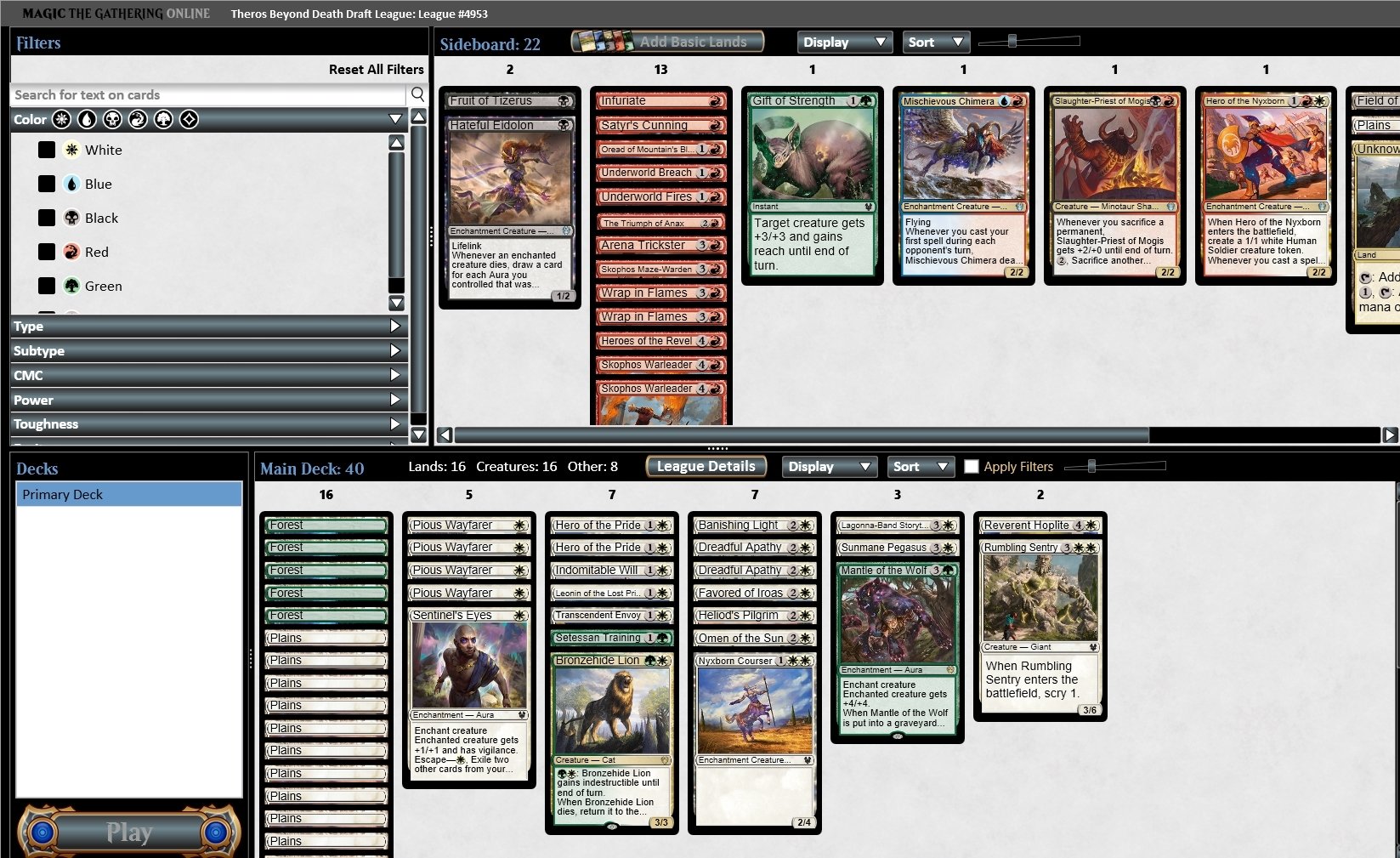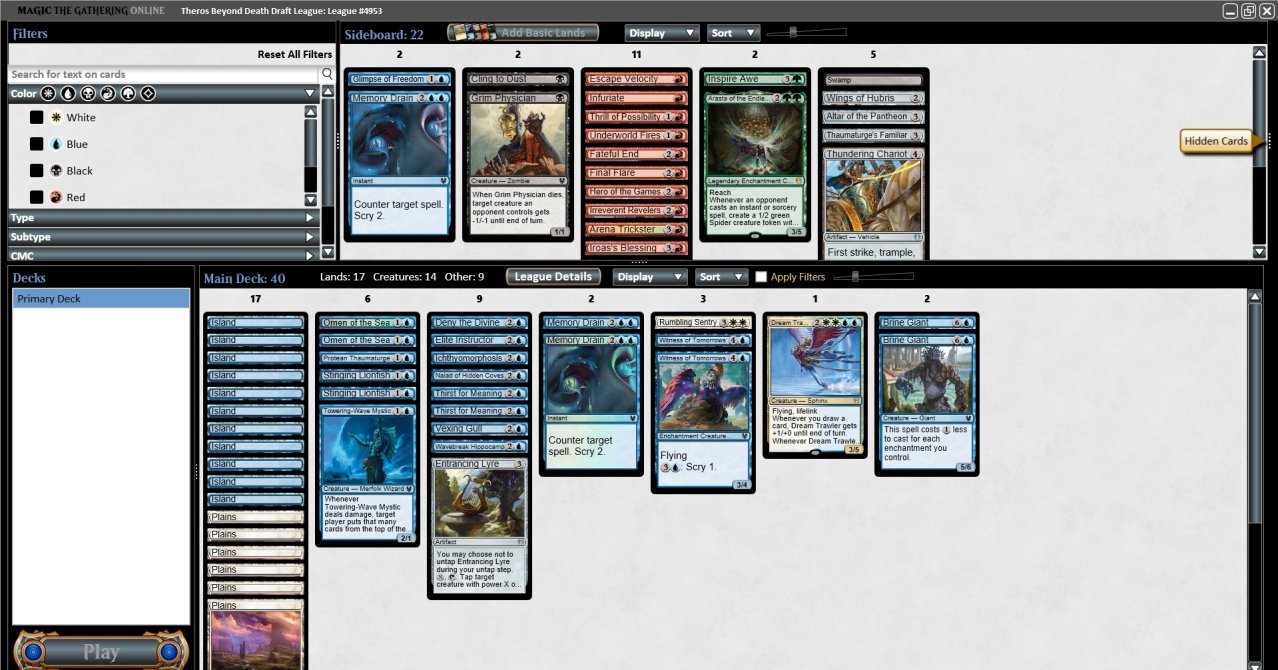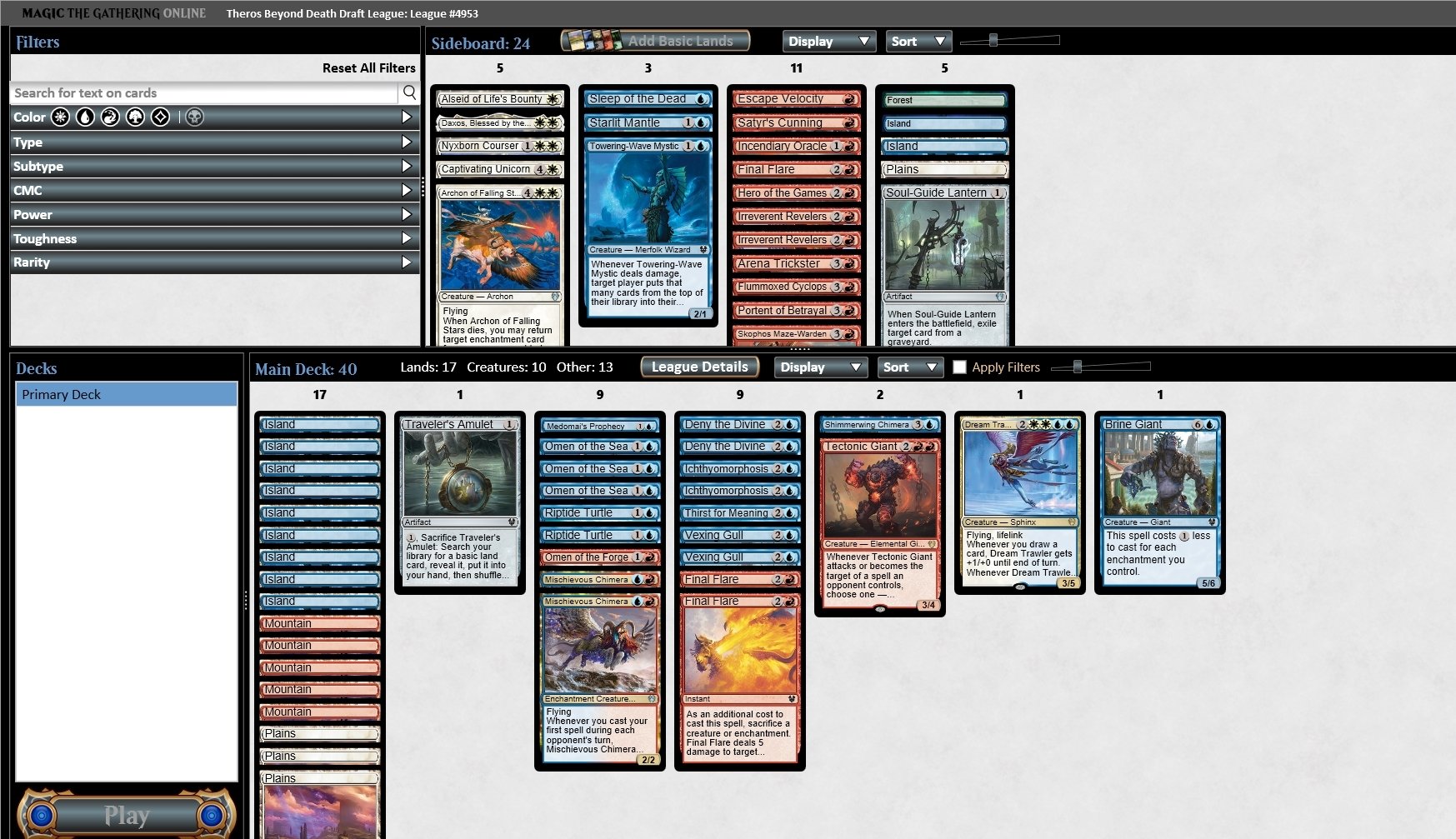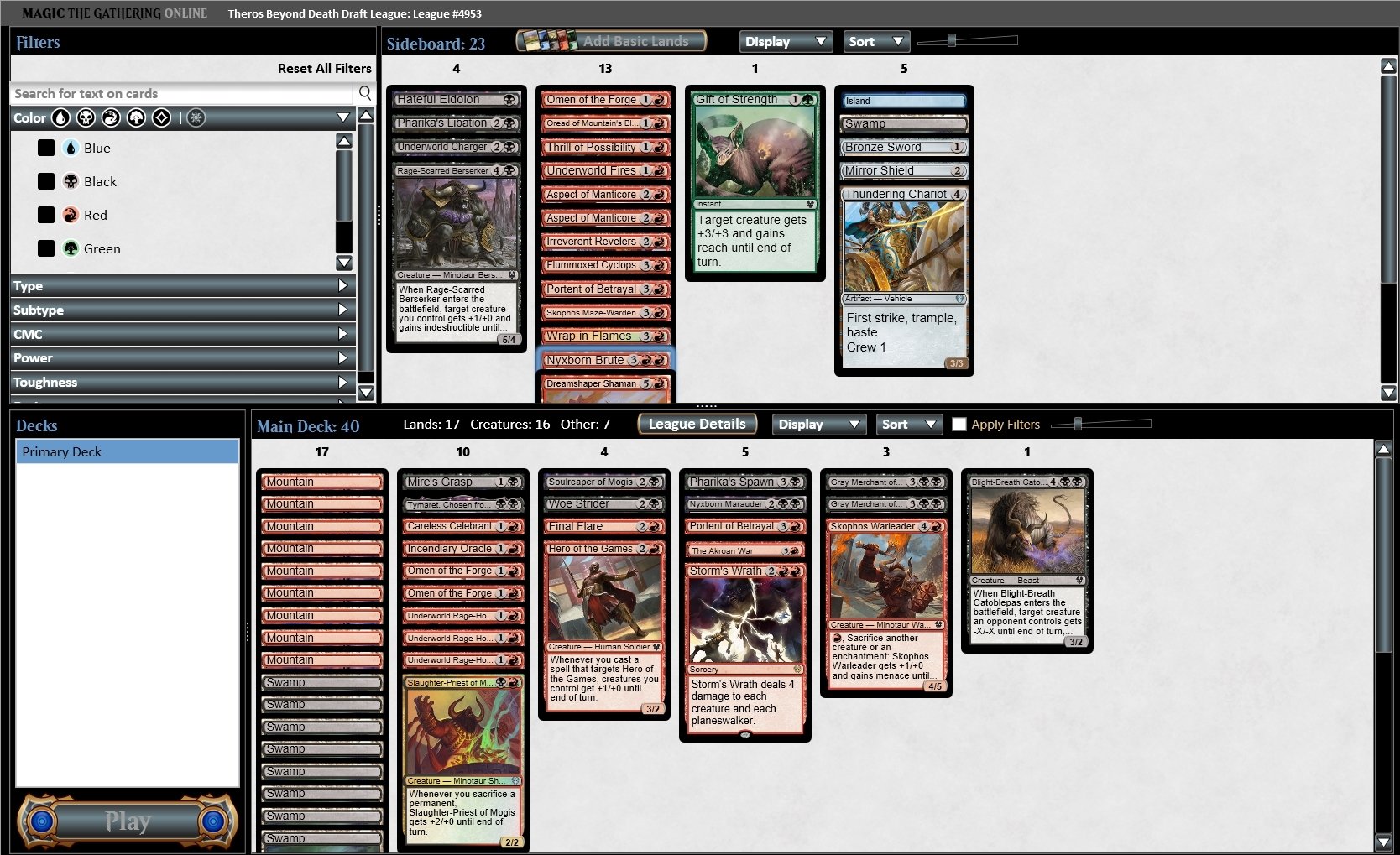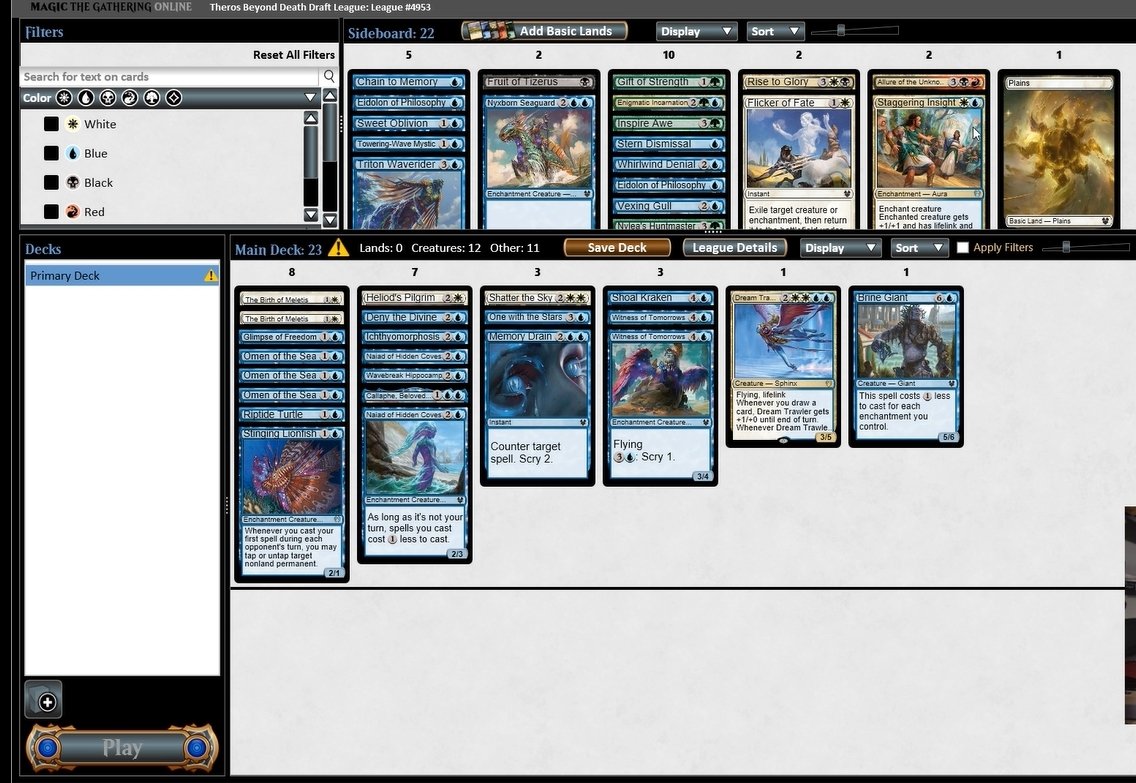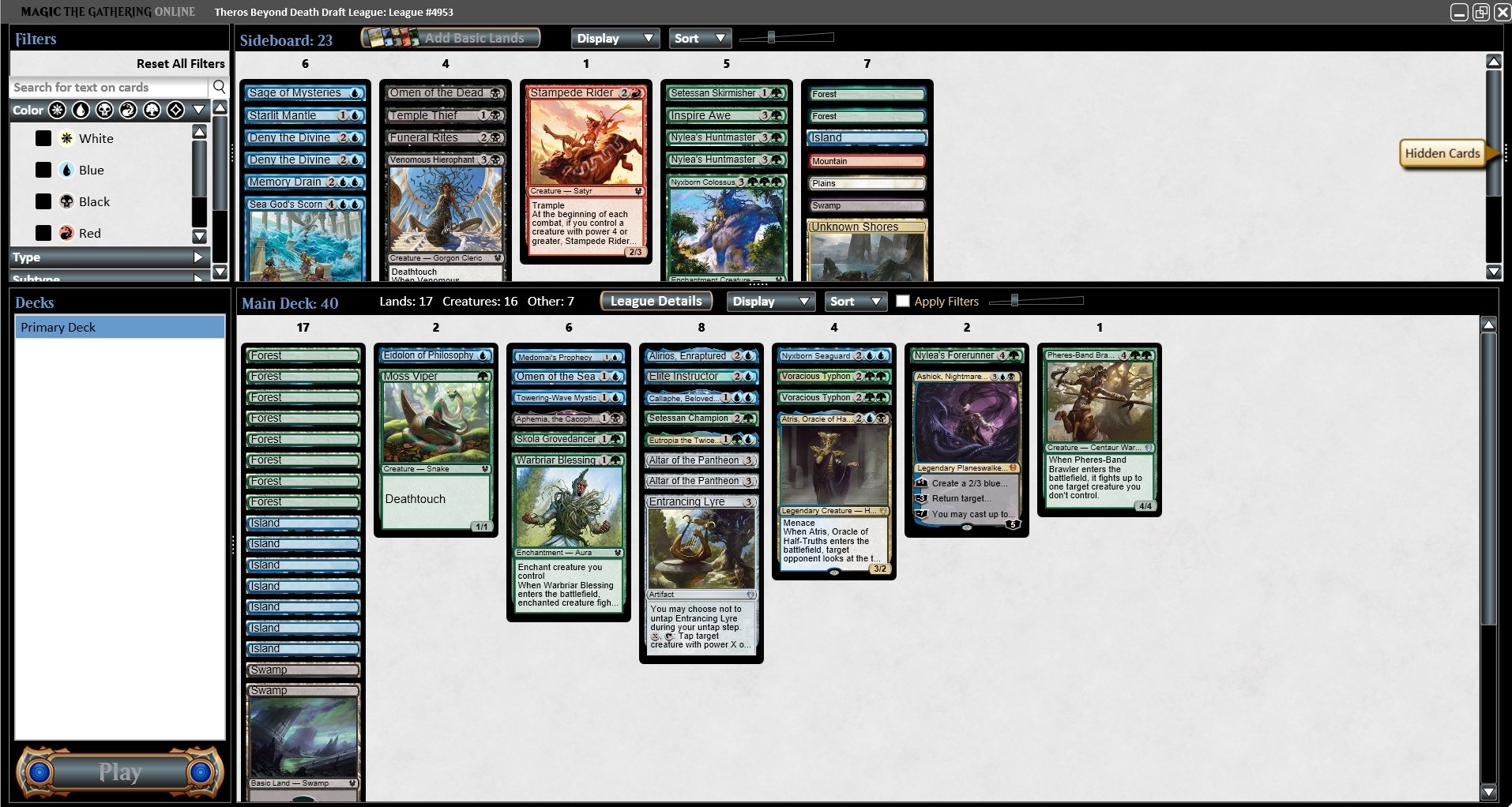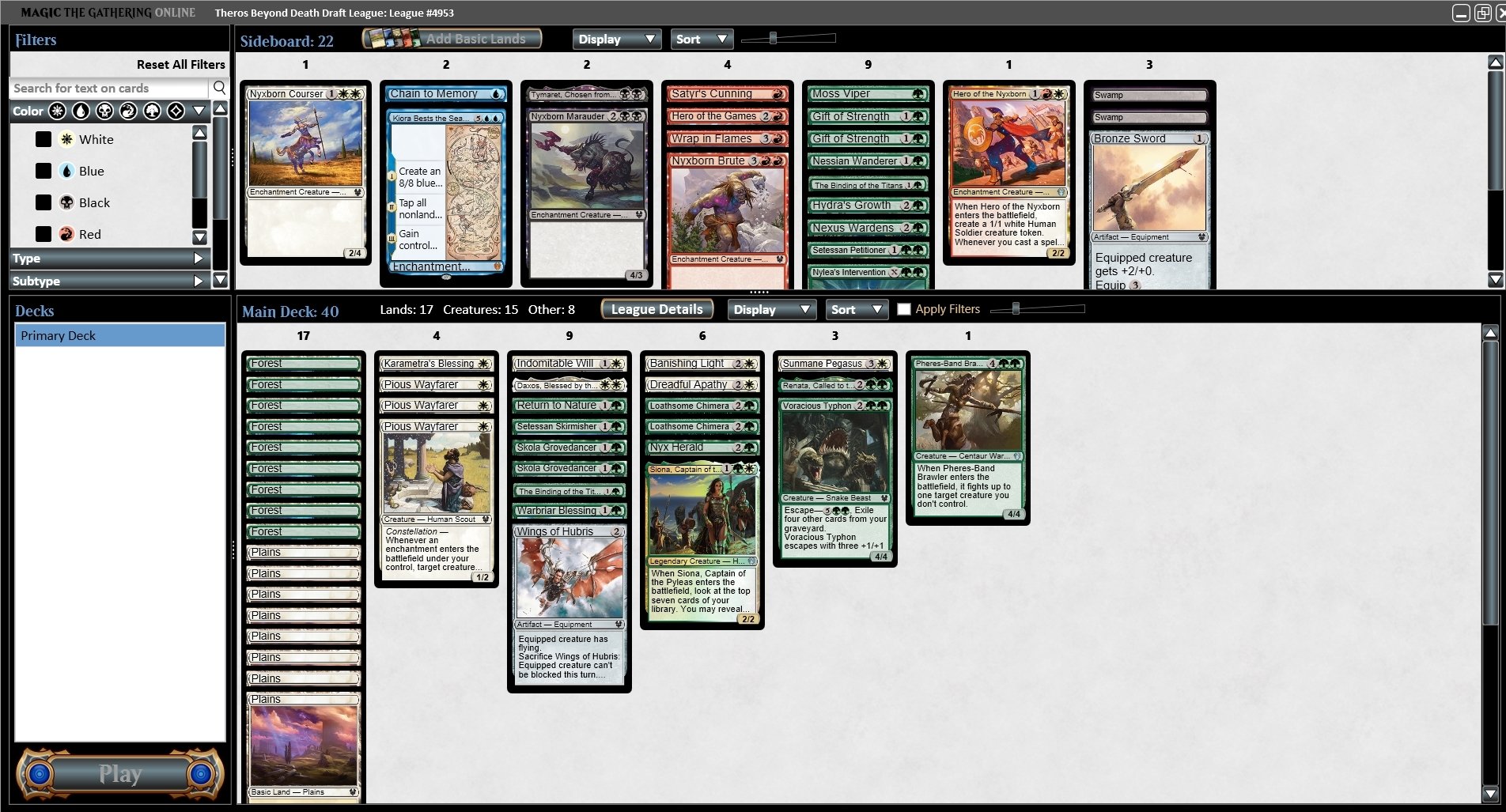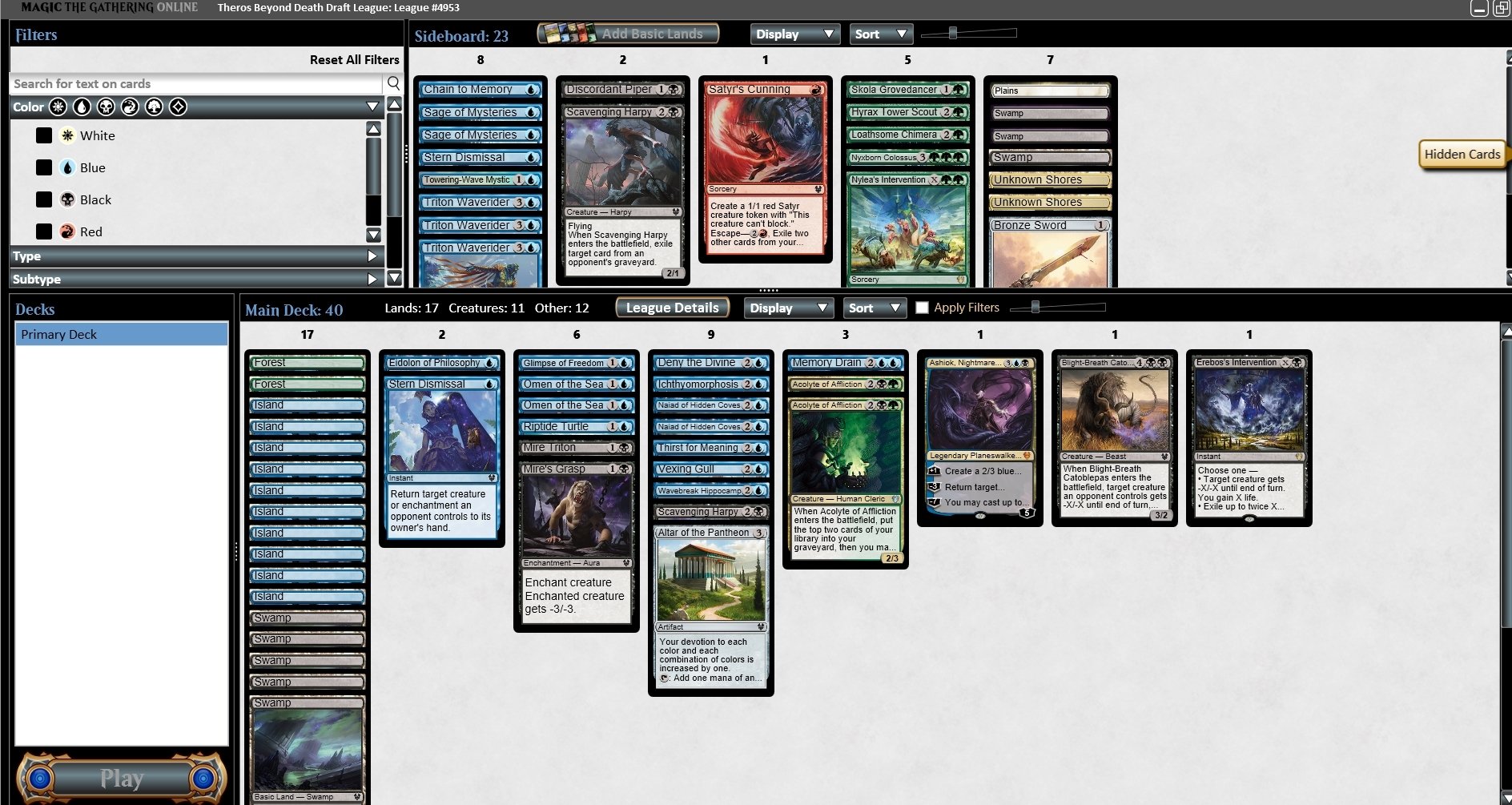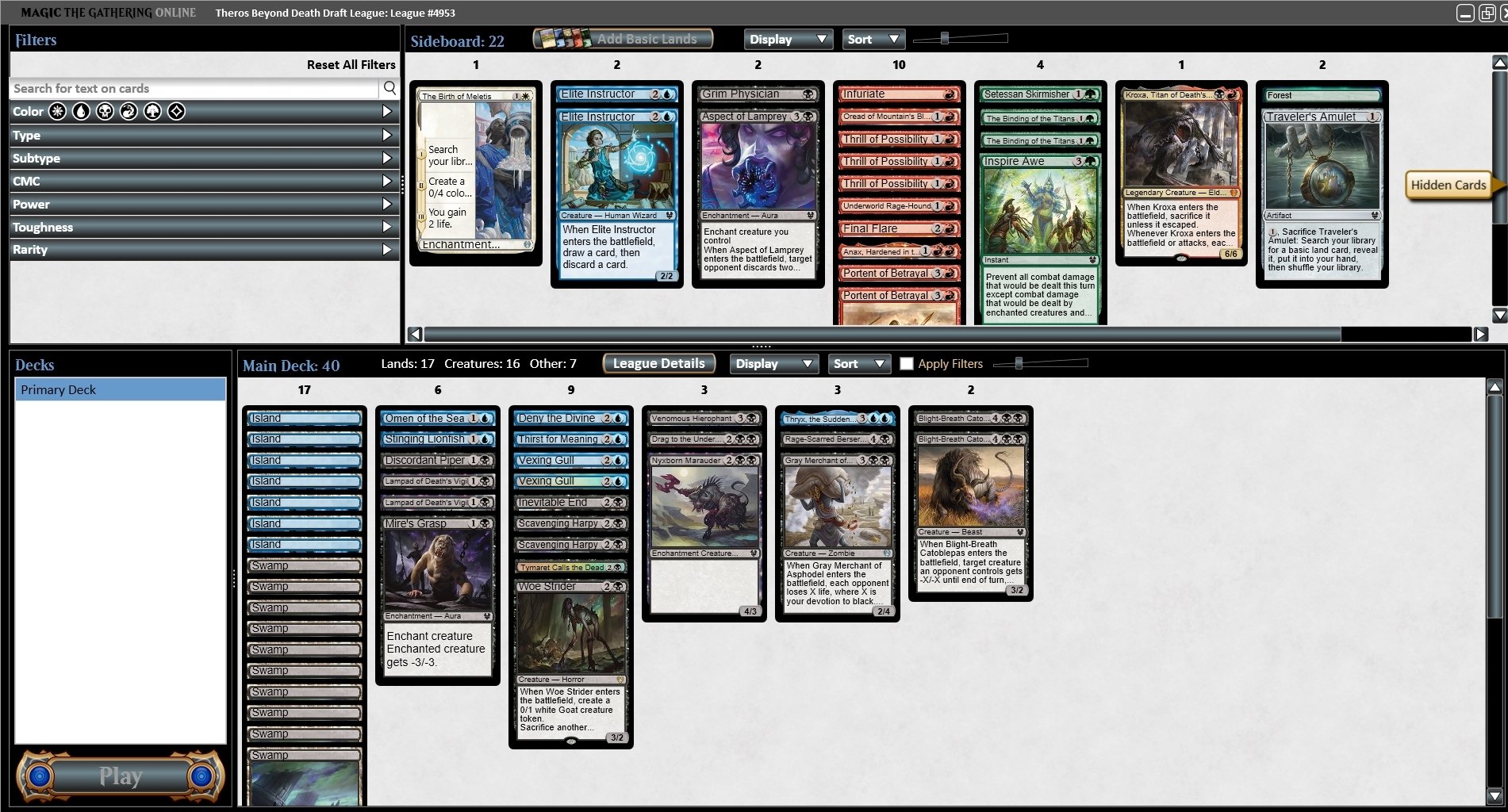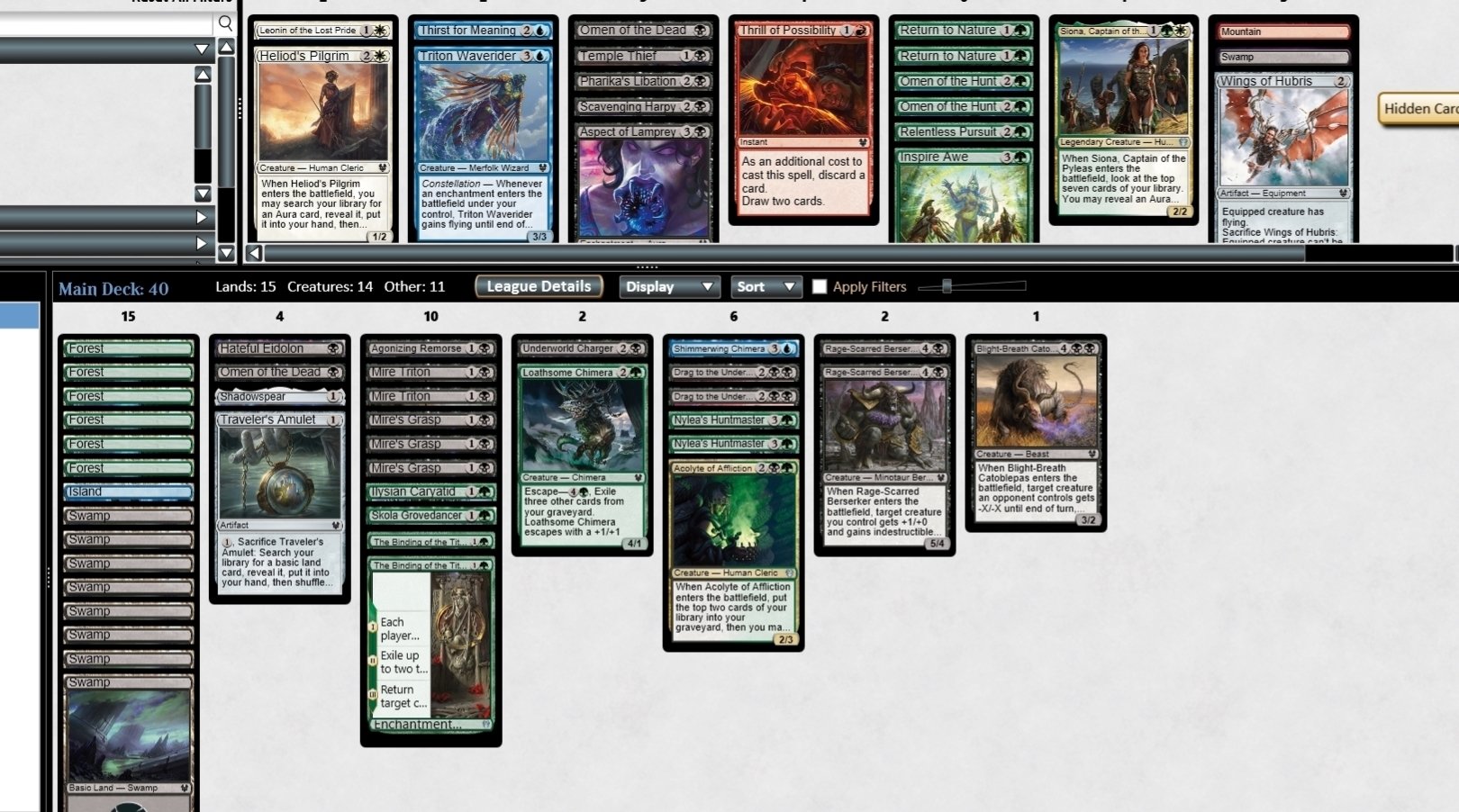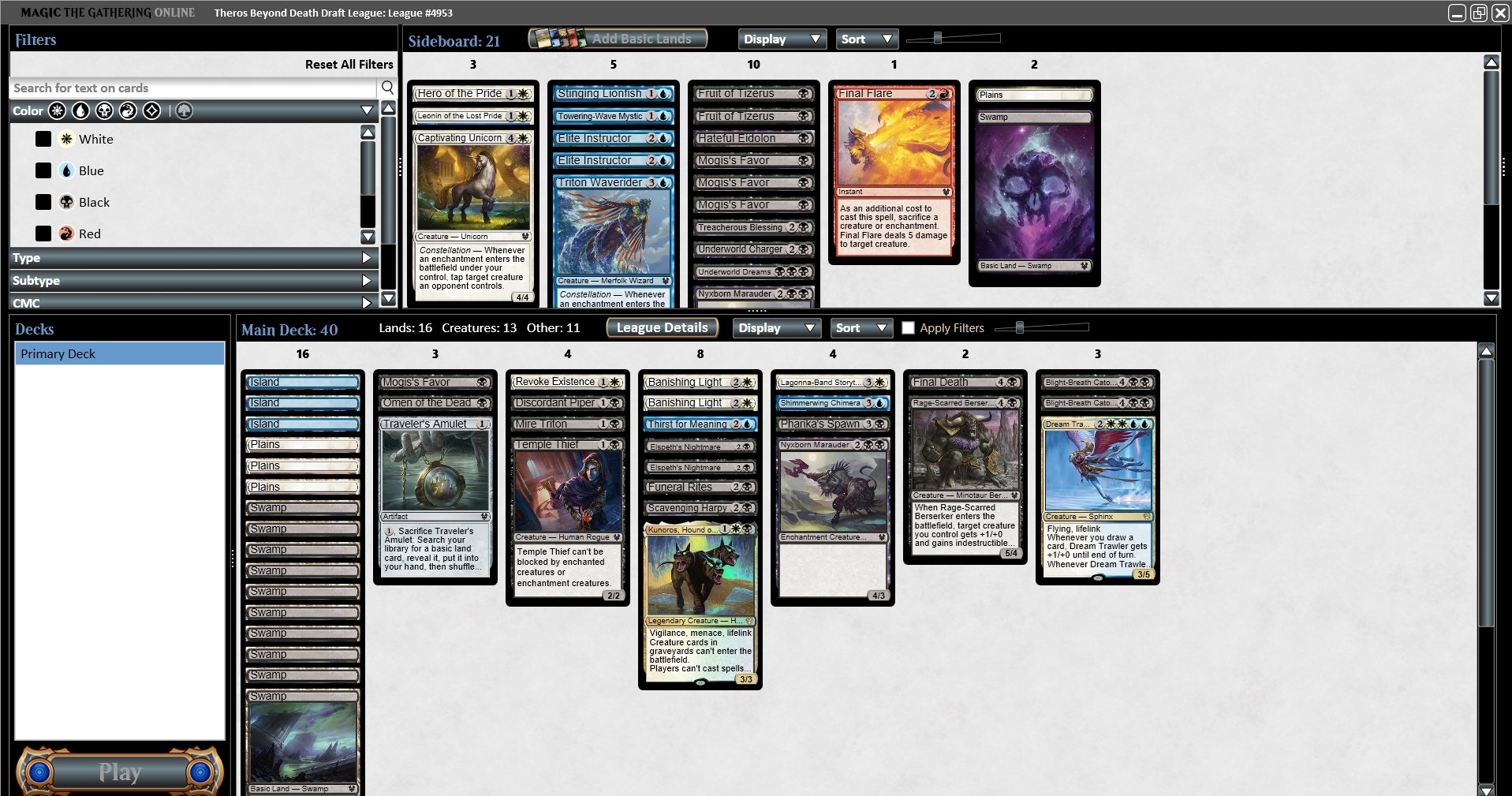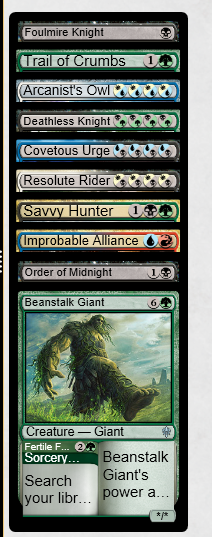Alex Nikolic (Chord_O_Calls)

If you haven’t
checked out my recent 10 000 word THB draft guide posted on draftsim.com, I’d
recommend giving that article a look before diving into this one. The article
shines a light on my thoughts/approach to the format which gives context to the
draft logs in this article and the way I ended up building the decks.
Since writing that article I’ve done 25 more drafts bringing the total number of times I’ve jumped into the queue to up 85. My thoughts on the format have largely remained the same, but I want to highlight some places where my approach has changed, update a few of my evaluations, and dive deeper into some aspects of the format that I wish I had touched on a bit more.
Since writing that article I’ve done 25 more drafts bringing the total number of times I’ve jumped into the queue to up 85. My thoughts on the format have largely remained the same, but I want to highlight some places where my approach has changed, update a few of my evaluations, and dive deeper into some aspects of the format that I wish I had touched on a bit more.
The 3-5
Colour Decks
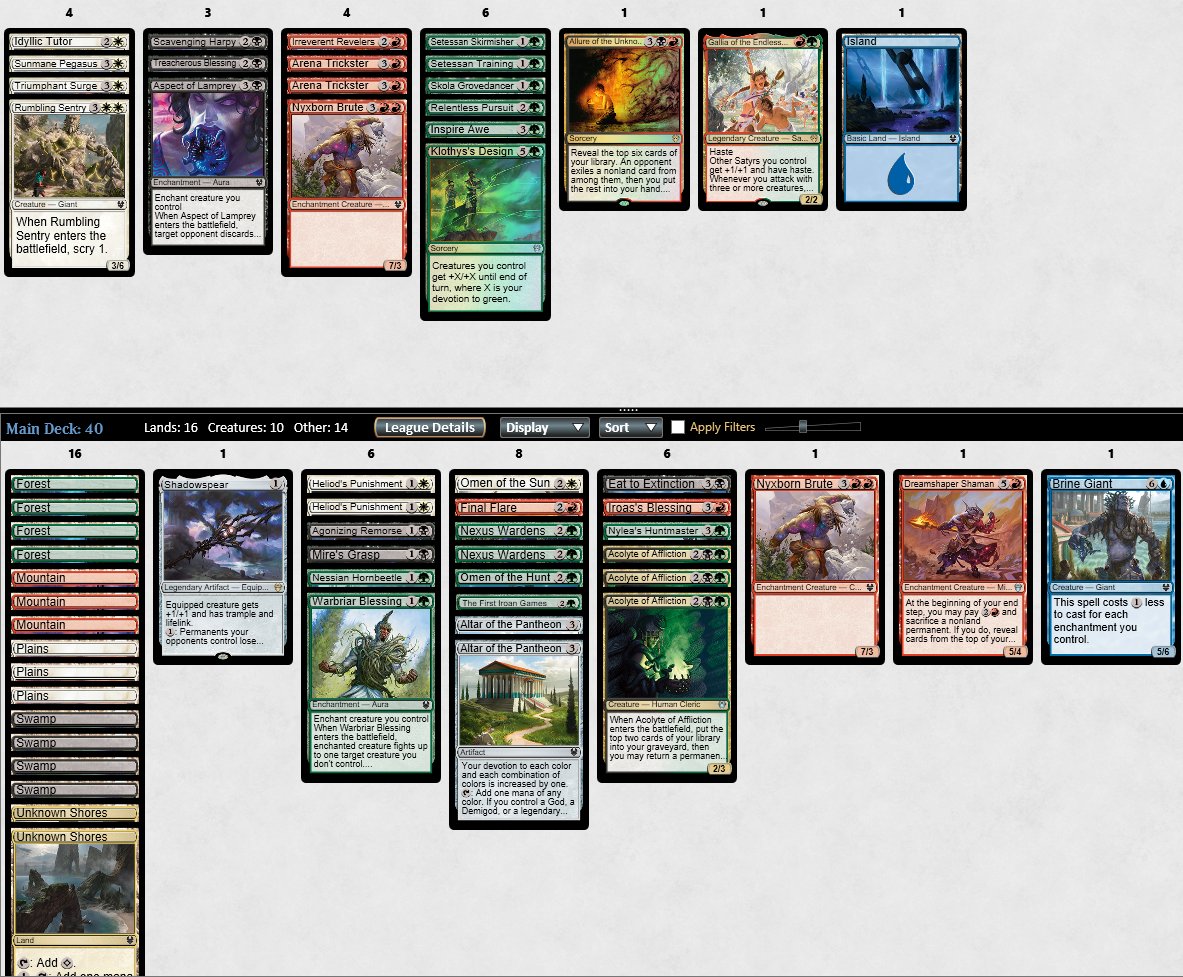
Deck credit to @Ghash77MTG on twitter
I go into a bit more depth on this archetype in the latest episode of Limited Level-Ups, but I want to give a rough outline here as well. My affinity
for drafting decks that play more than two colours has been the most notable change
to how I’ve been approaching THB drafts the past couple of weeks. Doing a quick
analysis of my draft logs, about 50% of my drafts have me playing some flavor
of multi-coloured deck.
I’m not necessarily biasing myself towards playing more than two colours, but these decks are what I’ve been defaulting to when no clear, synergistic two-colour lane presents itself to me in the first pack and a half of the draft.
In these drafts, we’ve started with a few powerful cards of different colours that we’ve picked up in the first 1-5 picks of the draft. Unfortunately, what tends to happens--especially when drafting at a table of proficient drafters--is the power level of the pack rapidly flattens for picks 6-12 resulting in weaker signals and making it tricky to make an informed decision when choosing between two or three C level commons in the back half of a pack.
When my
draft is headed in this direction, my focus shifts from trying to find the most
open colour pair to navigating into a base colour--usually Blue or Green--and
prioritizing ways to play all the good cards in my pile. When I find myself in
this spot, my pick priorities shift from taking mid-level playables in my
potential colours, to taking as much fixing and filtering I can get my hands on.
The Fixing
The mana fixing in Theros Beyond Death is just about the best we can ask for without having access to common dual lands.



Multiple five-colour fixers at common means that you can be fairly ambitious with the number of colours you play and even the number of double pipped cards you include. If I have 2 Ilysian Caryatids, an Altar of the Pantheon, and 2 Traveler’s Amulets, I feel comfortable splashing two double-pipped A-tier bombs like Thryx, the Sudden Storm, and Archon of Sun’s Grace in my base Green deck.


When you’re playing 4+ colours, Unknown Shores becomes a playable card. In a 3 coloured deck, basic land of your splash colour is nearly strictly better than Shores, but when the card turns into a 4-5 colour fixer, it pulls it’s weight.
The Fixing
The mana fixing in Theros Beyond Death is just about the best we can ask for without having access to common dual lands.



Multiple five-colour fixers at common means that you can be fairly ambitious with the number of colours you play and even the number of double pipped cards you include. If I have 2 Ilysian Caryatids, an Altar of the Pantheon, and 2 Traveler’s Amulets, I feel comfortable splashing two double-pipped A-tier bombs like Thryx, the Sudden Storm, and Archon of Sun’s Grace in my base Green deck.


When you’re playing 4+ colours, Unknown Shores becomes a playable card. In a 3 coloured deck, basic land of your splash colour is nearly strictly better than Shores, but when the card turns into a 4-5 colour fixer, it pulls it’s weight.

Deck credit to @Ghash77MTG on twitter
The Filtering



While the fixing in THB is great, the linchpin of the 4-5 colour decks are cards that help you filter. The 4-5 colour decks are allowed to exist in the format nearly exclusively thanks to volume of filtering there is in the set coupled with the fact that the speed of the format allows for the time to cast a few non-board impacting spells in the early game.
Without four or five ways to
dig for your high impact cards or pitch the excess mana sources, you
risk flooding or getting run over by a more streamlined deck. Prioritize these
cards even above the fixing, a deck running 4-5 colour with slightly sketchy
mana can still adhere to the old “card draw is fixing” adage.
White is the Second Deepest Colour
White is the Second Deepest Colour
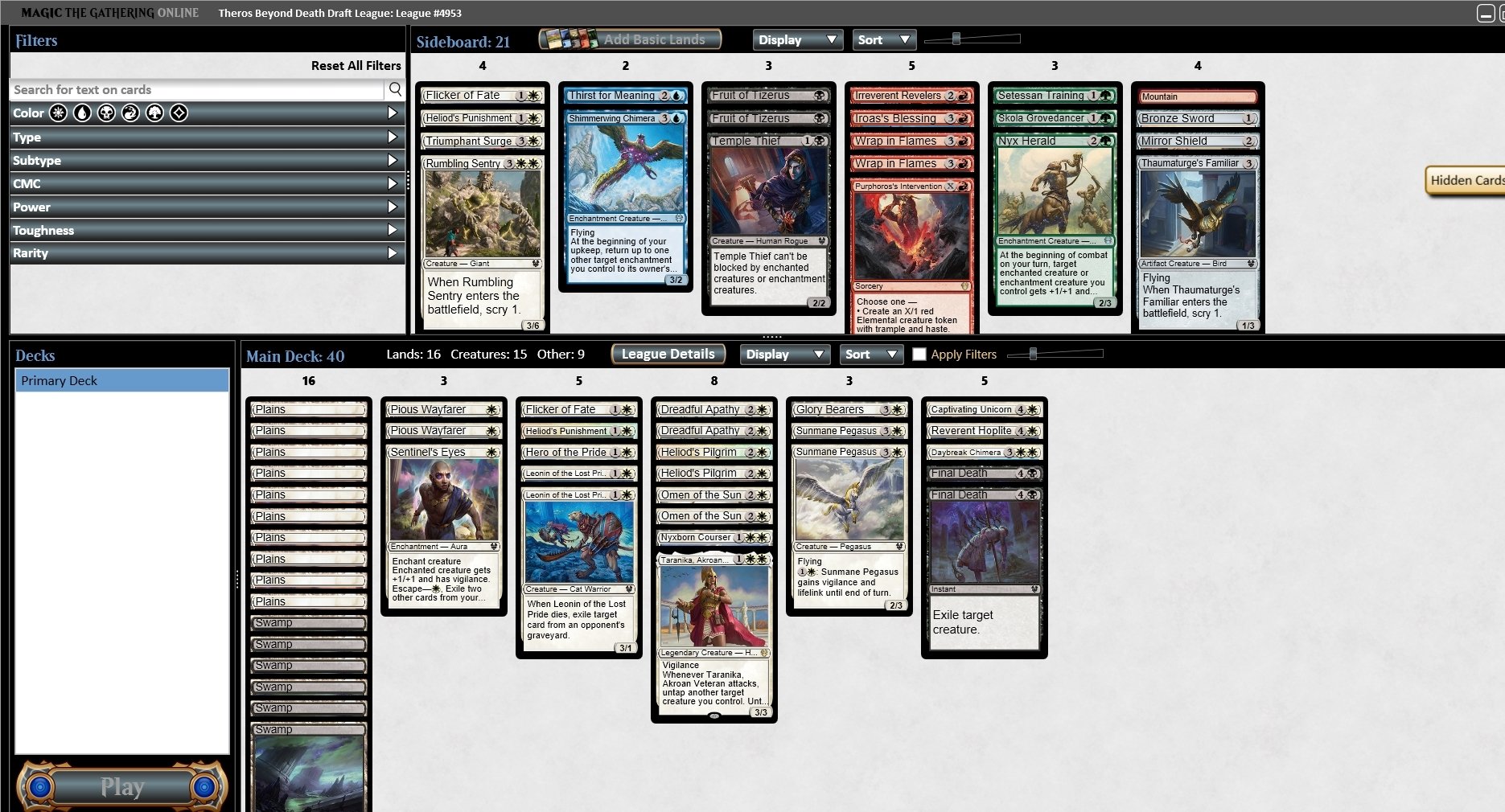
At this point in the format, most players are drafting with the understanding that Black is the deepest colour. While I still believe this is true, I think that White is a reasonably close second. Like Black, you have to go fairly far down the list of White commons before you get to a card that you’re unhappy to put in your deck. I mentioned in my draft guide that the White aggro decks were quite good, but I wish I had emphasized this a bit more. Anytime my opponent curves Pious Wayfarer into any two drop, I start to sweat a bit.
A Clarification and Update on Green/White


In my draft guide, I had GW listed as the only “Tier 3” deck. I want to
emphasize that tier 3 doesn’t mean the deck is bad, it just
means that I personally find myself in the deck less often than the other decks,
and when I do, I haven't found the ceiling on GW decks without rares to be notable high.
That being said, I’ve had a few conversations with players I very much respect (mainly BeersSC, a player who holds nearly twice as many trophies as I do) who have said that GW is a deck they are fond of and find themselves in often.This is largely a function of white being undervalued in relation to how good the colour actually is.
Siona is a card I sort of dunked on in my draft guide and a card that I was ultimately too low on. I was viewing the card as a largely worse Heliod’s Pilgrim in most cases, but I don’t think that’s giving her enough credit. To paraphrase my Limited Level-Ups co-host Abram, she doesn’t go in every GW deck, but the ones that she does belong in, she’s very powerful and is one of the better cards in your deck. I’m a player who tends to evaluate cards in the context of their best homes and that evaluation makes a lot of sense to me, so I’m a bit sad that it took me so long to get to where I am on the card.
I want to reiterate that I don’t think tiers mean all that much, especially in a set with archetypes that are so close in power like Theros Beyond Death, but if I had to go back and do it again, I’d group GW in with the rest of the tier 2 decks.
That being said, I’ve had a few conversations with players I very much respect (mainly BeersSC, a player who holds nearly twice as many trophies as I do) who have said that GW is a deck they are fond of and find themselves in often.This is largely a function of white being undervalued in relation to how good the colour actually is.
Siona is a card I sort of dunked on in my draft guide and a card that I was ultimately too low on. I was viewing the card as a largely worse Heliod’s Pilgrim in most cases, but I don’t think that’s giving her enough credit. To paraphrase my Limited Level-Ups co-host Abram, she doesn’t go in every GW deck, but the ones that she does belong in, she’s very powerful and is one of the better cards in your deck. I’m a player who tends to evaluate cards in the context of their best homes and that evaluation makes a lot of sense to me, so I’m a bit sad that it took me so long to get to where I am on the card.
I want to reiterate that I don’t think tiers mean all that much, especially in a set with archetypes that are so close in power like Theros Beyond Death, but if I had to go back and do it again, I’d group GW in with the rest of the tier 2 decks.
Sleep of the Dead

Just before we
get to the trophies, I want to highlight a card that I’m sure isn’t on most
people’s radars still. Sleep of the dead isn’t a card that goes in every Blue
deck, in fact it doesn’t go in most Blue decks, but in a good tempo driven UR deck
It’s often one of the best cards in your 40.
🏆 Sleep of the dead is the card i have been most wrong about from initial spoiler until now. Card is pretty legit in this kind of deck. https://t.co/rJG3QgRs6c pic.twitter.com/t4X0ptCv2V— Lars Dam (@_Malavi_) February 22, 2020
Sleep of the Dead is
to UR what Wrap in Flames is to RW: a niche card that doesn’t belong in most
decks but is one of the most important cards in its respective archetype. Locking
down your opponent’s Voracious Typhon or large flier for a turn or two is generally
all UR needs to get it’s Vexing Gulls in for a few more pecks and lock up the
game. In addition, Blue and Red have very few escape cards so often, the grave
is a wasted is a resource that your UR decks are begging you to use. This is never a
card you have to pick early but be aware of it in packs that you’ll be able to
wheel it.
The Trophy Decks and Draft Logs
Deck #1
Draft Log: https://magic.flooey.org/draft/show?id=tzJKX-fnlO2H5HxkQq5vQK3oLWA
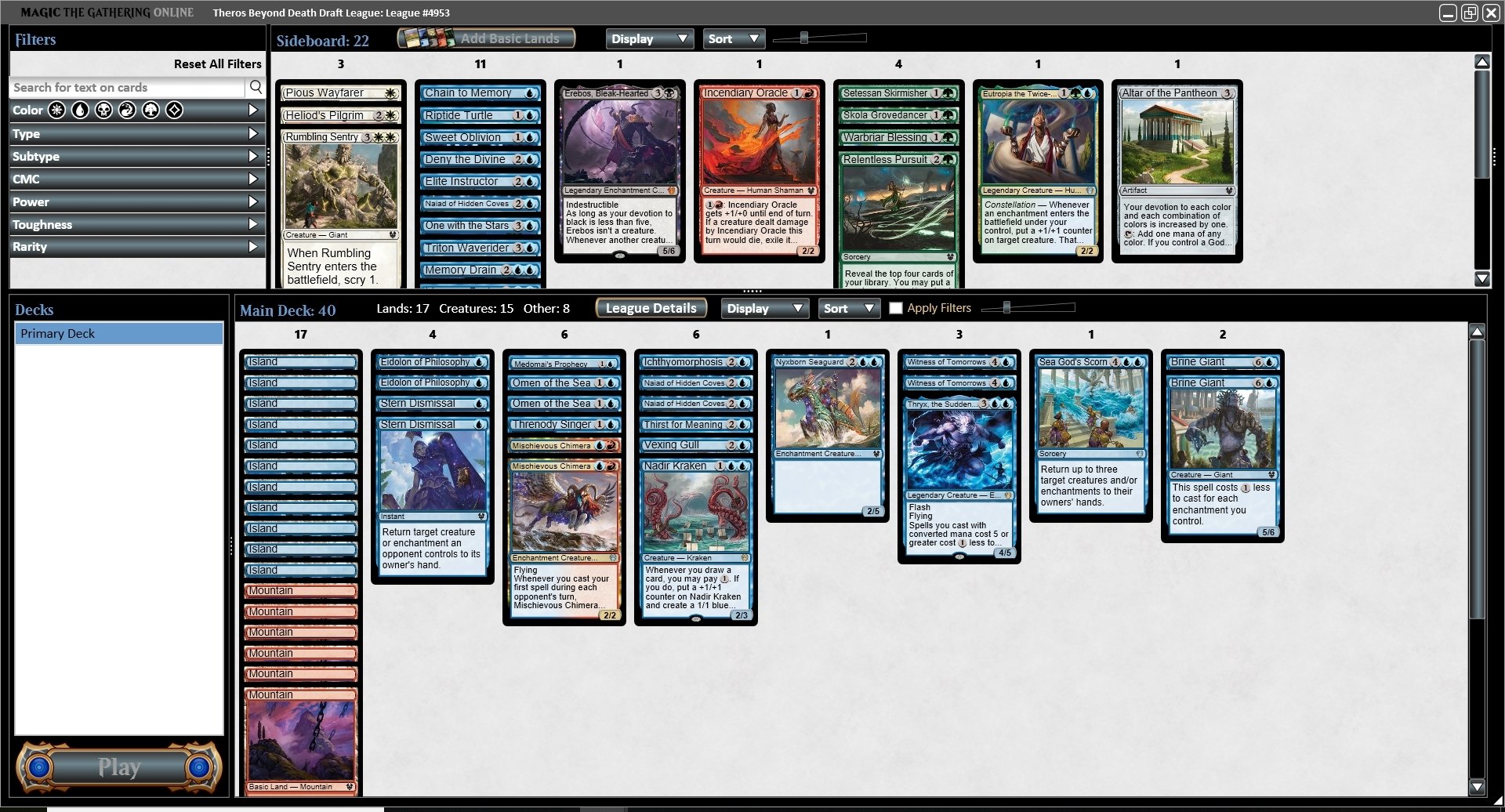
The Trophy Decks and Draft Logs
Deck #1
Draft Log: https://magic.flooey.org/draft/show?id=tzJKX-fnlO2H5HxkQq5vQK3oLWA

Deck #2
Draft Log: https://magic.flooey.org/draft/show?id=LFA_QDH-LstSWJzORfYClmz1ODs
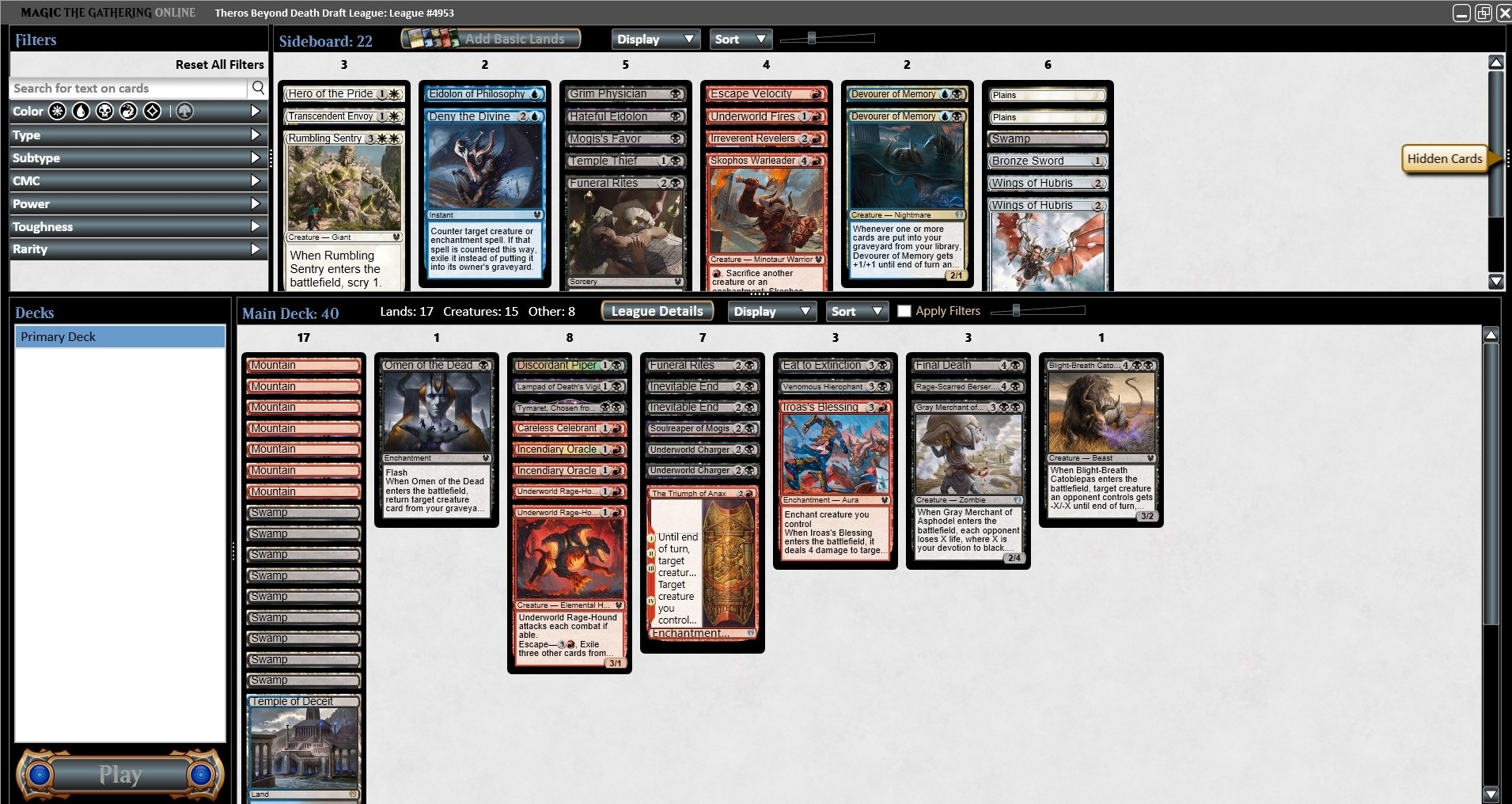
Deck #3
Draft Log: https://magic.flooey.org/draft/show?id=bhP2_2FjNUGHlfL_AqBlw1weJyk
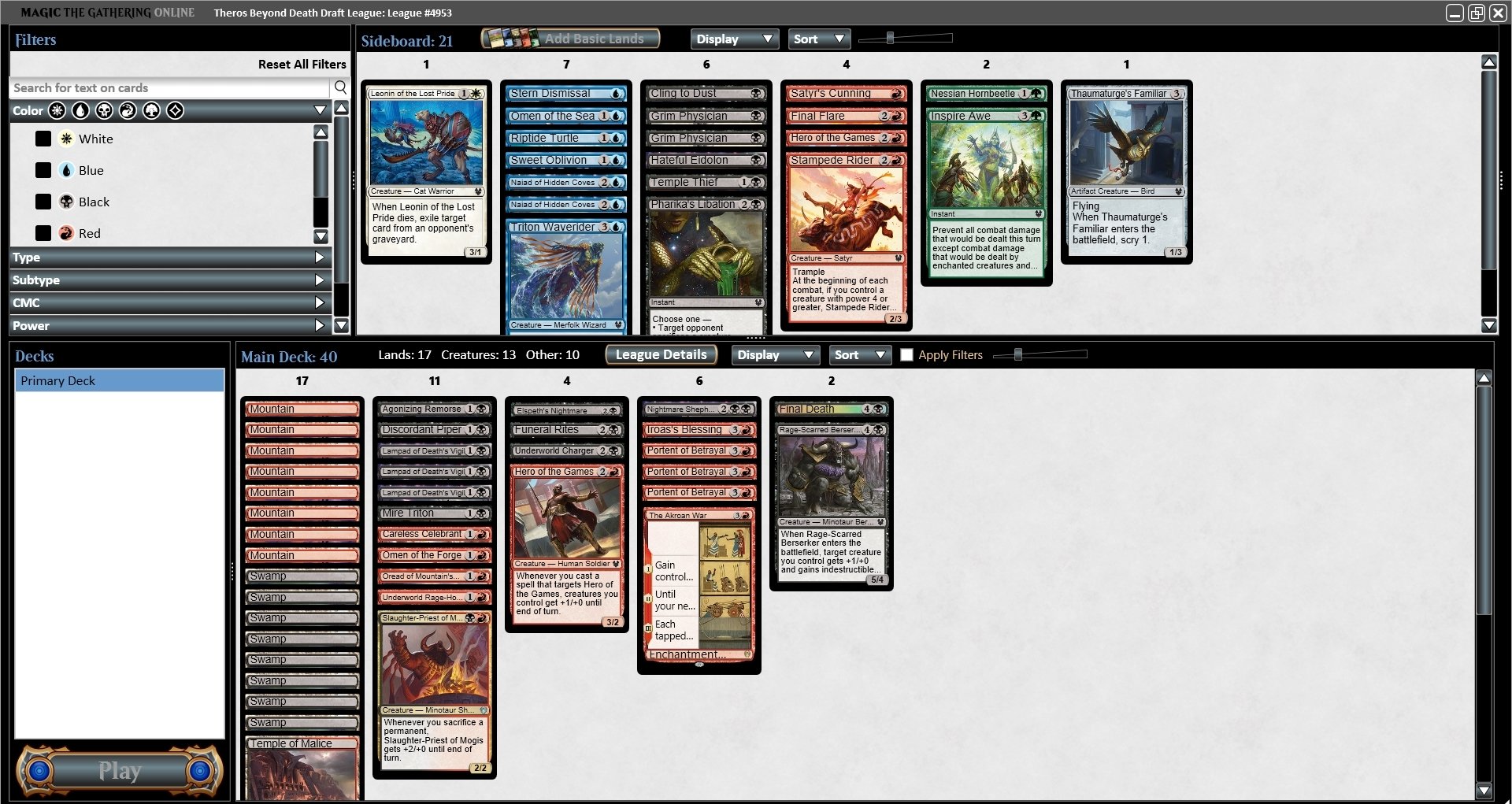
Draft Log: https://magic.flooey.org/draft/show?id=LFA_QDH-LstSWJzORfYClmz1ODs

Deck #3
Draft Log: https://magic.flooey.org/draft/show?id=bhP2_2FjNUGHlfL_AqBlw1weJyk

Deck #4
Draft Log: Log for this was lost unfortunately.
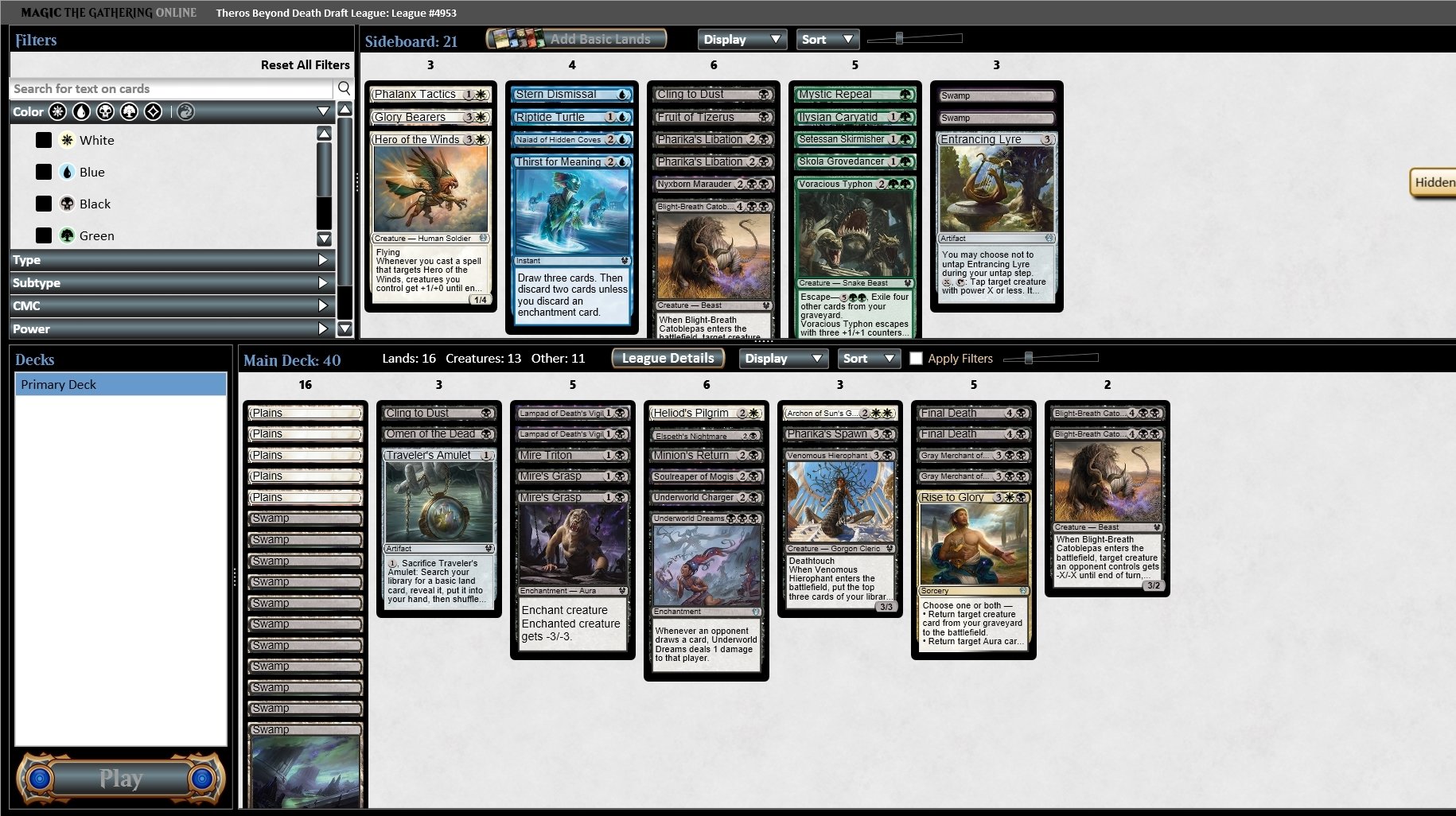
Draft Log: Log for this was lost unfortunately.

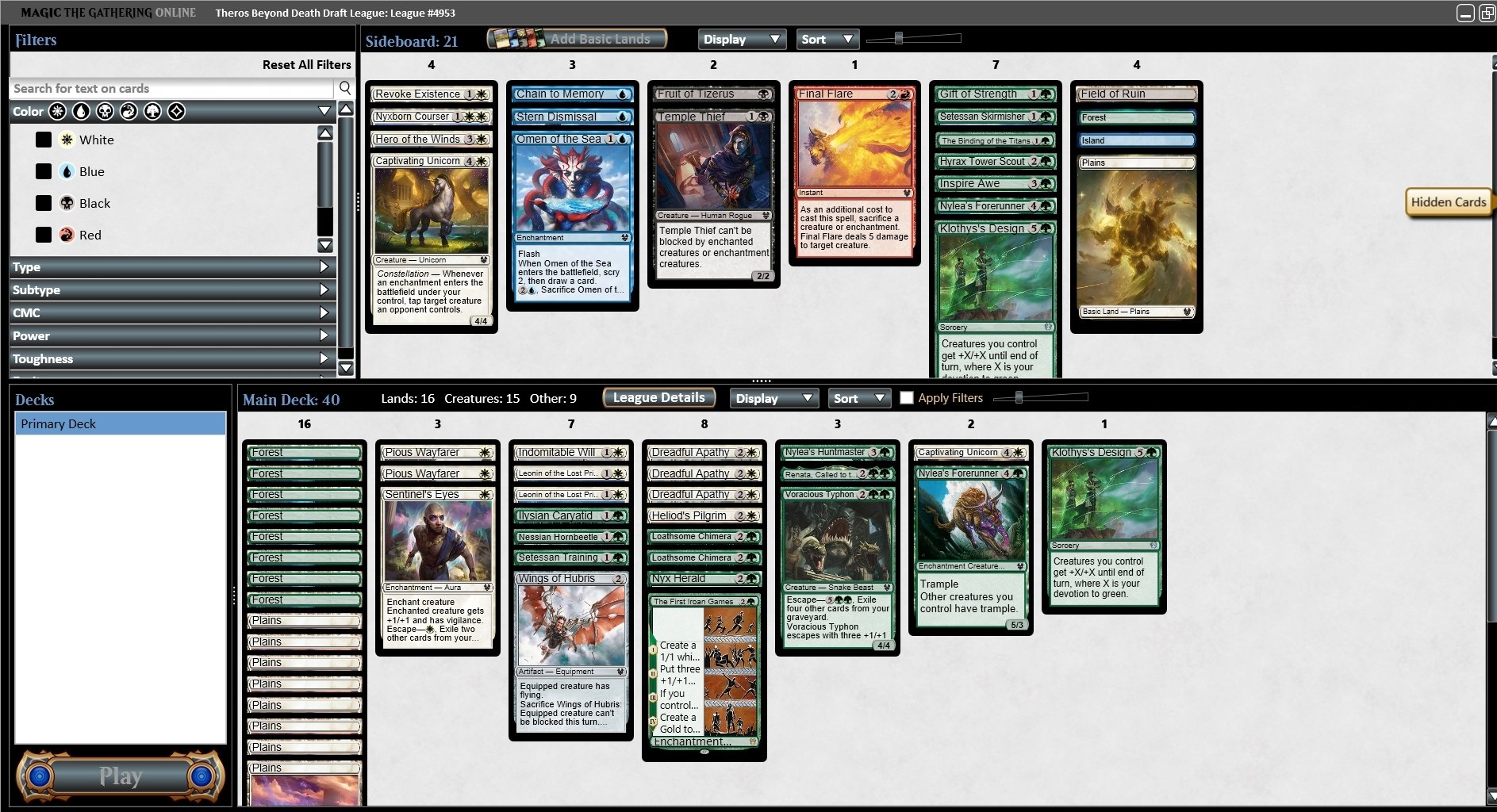
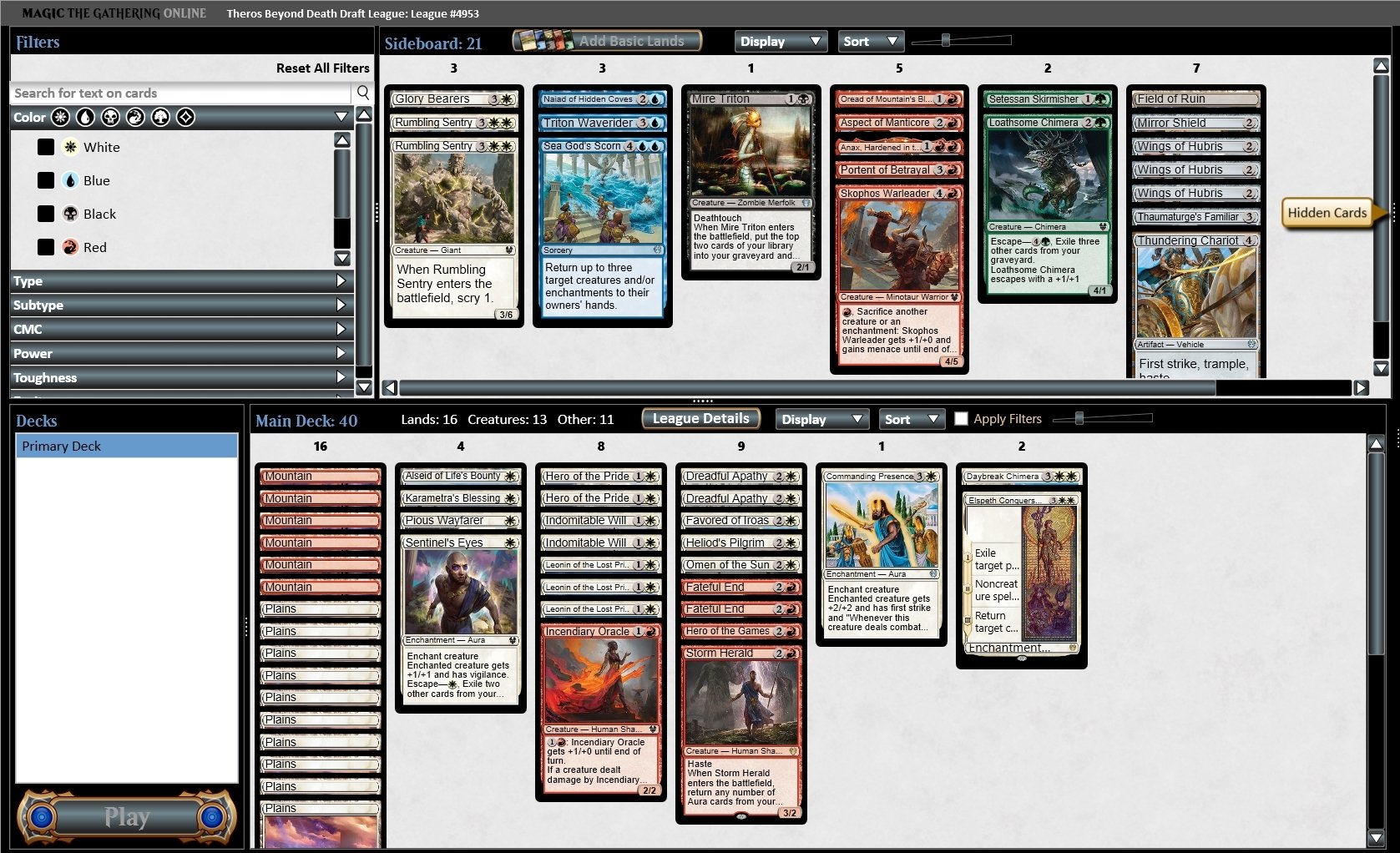
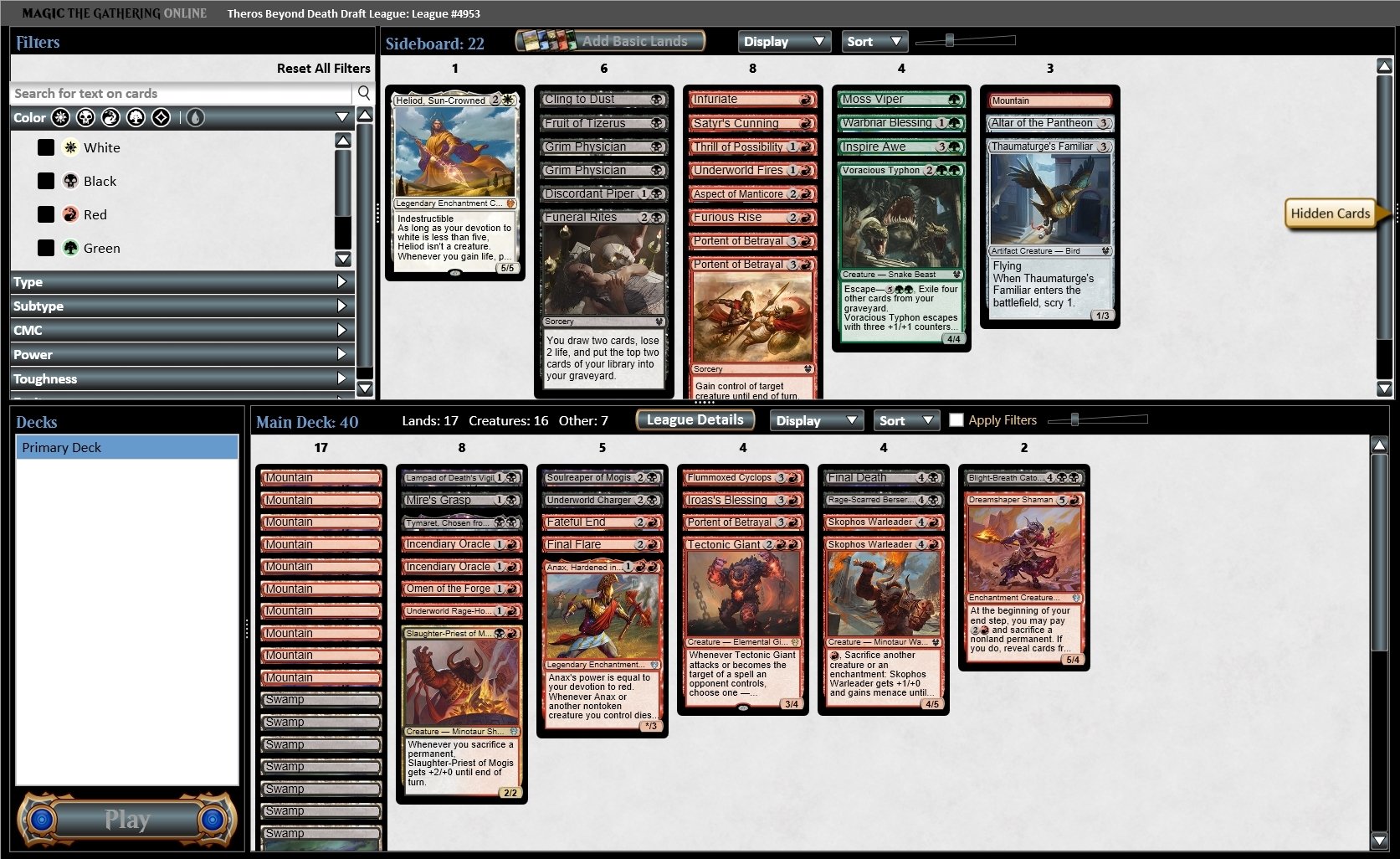
Deck #9
Draft Log: Log for this one was also lost ☹
Draft Log: Log for this one was also lost ☹
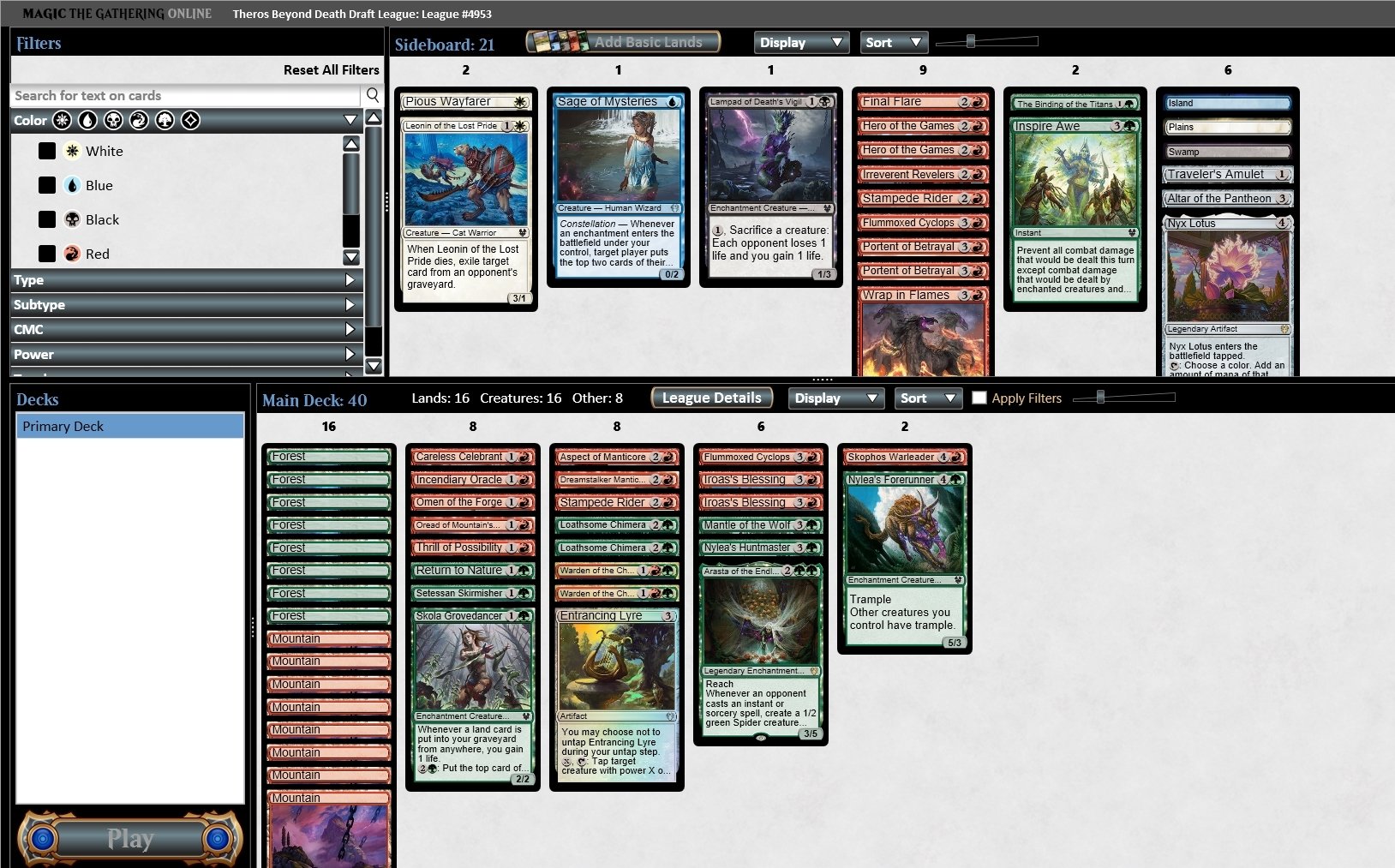

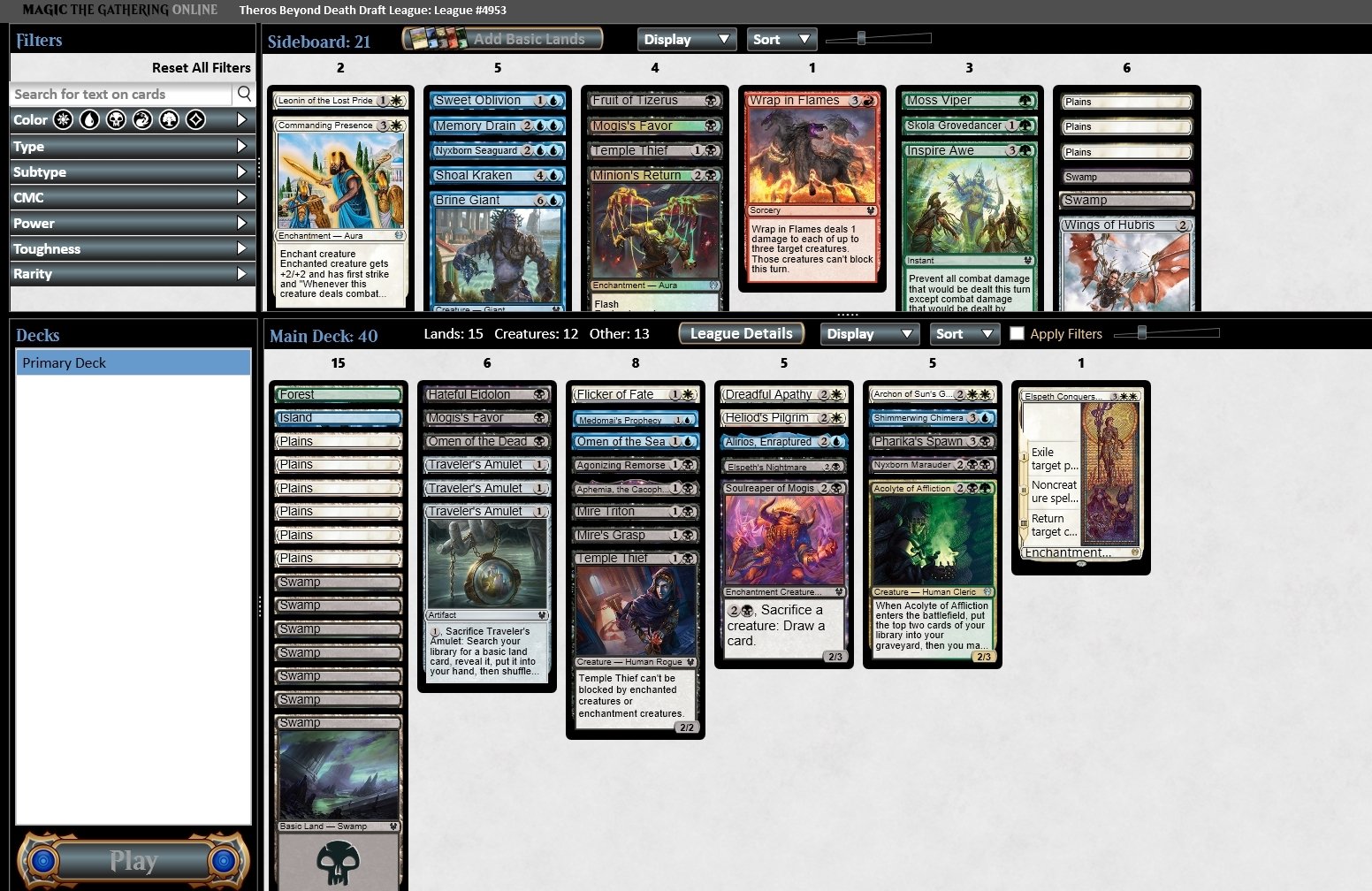
Deck #19
